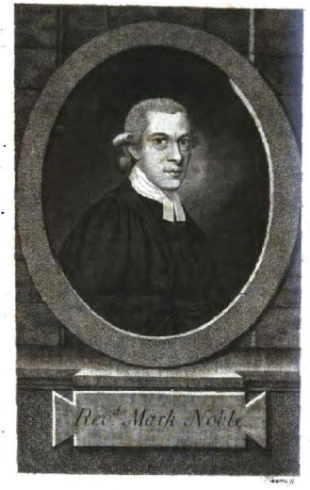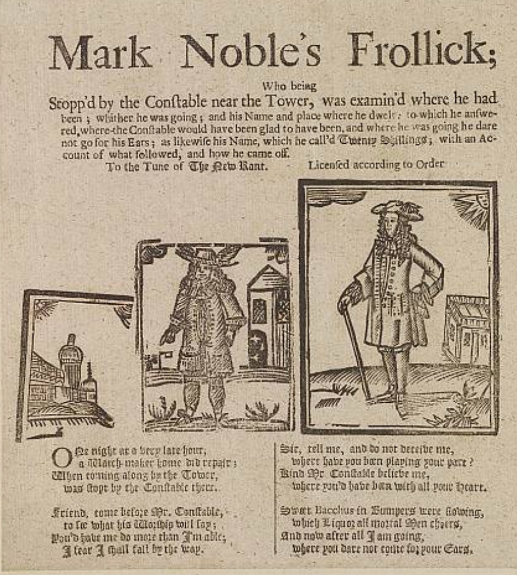A little while ago I was reading about the late 18th-century English clergyman, biographer and antiquary, Mark Noble (1754-1827), author of several works including Two Dissertations on the Mint and Coins of the Episcopal Palatines of Durham (1780) and A Genealogical History of the present Royal Families of Europe (1781). About an hour later, I was reading the Guardian when I came across a paragraph about the English former professional footballer, who played for West Ham United for 18 years, Mark Noble.
Here is Mark Noble, 18th-century antiquarian, in a 1784 engraving by Robert Hancock.
Here is Mark Noble, central midfielder and prolific penalty scorer, taking a free kick during the 2012-13 season.
I wondered about all the other Mark Nobles, and soon came up with a list – not exhaustive, but giving a sense of the phenomenon.
On 25 April 1807, a patent was issued for a chain-pump, hand-pump, and an improved extinguishing fire-engine, to Mark Noble, engine maker, living in the parish of Battersea, in the county of Surrey.
On 23 March, 1896, Mark Noble, 31, was found guilty of shooting his brother, William Morris Noble, a printer living at 22 Milner Square, Islington, ‘with intent to murder’. William reported: ‘on the evening of February 2nd, about ten, I was sitting at the table playing cards with two ladies and two gentlemen, when the prisoner came into the room – my friends turned round and welcomed him, and asked him to join the game – I said nothing – he said, “Aha, aha! A hearty welcome!” and at the same moment I felt a shot in my side – I heard a report, and saw just the reflection of a flash” – as I was falling, my brother said, “You have blighted my life, and ruined my prospects.”’
At the 1984 Summer Olympics in Los Angeles, the UK team in the men’s cycling 4km pursuit – Steve Bent, Paul Curran, Adrian Timmis, and Mark Noble – came 12th, with a time of 4:36.74, and failed to qualify.
On 21st December 1823, 18-year-old Mark Noble was found guilty of stealing forty pounds of lead from the roof of a house in Hackney Road, London, at the value of 4 shillings, the goods belonging to James Waddilove. Mark Noble was transported for 7 years.
New Zealand athlete Mark Noble (born 30 September 1962) is both an International Correspondence Chess Grandmaster and the winner of many lawn bowls titles, competing in both able-bodied and para-sport events (his hip was smashed by a motorist when he was 13).
In 2015, Mark Noble published American poetic materialism from Whitman to Stevens (Cambridge University Press).
In 2002, Mark Noble published The cardiovascular system in health and disease (Imperial College Press).
In 2008, Mark Noble published Drupal 6 site builder solutions: build powerful web site features for your business and connect to your customers through blogs, product catalogs, newsletters, and maps (Packt Publishing).
At some point in the 1670s, 80s, or 90s, diarist and naval administrator Samuel Pepys bought a copy of a broadside ballad to add to his growing collection. The ballad told a story of a watchmaker stopped at night by a city constable, who asked ‘where he had been; whither he was going; and his Name and place where he dwelt.’ The ballad was titled Mark Noble's Frollick, to be sung ‘To the Tune of The New Rant.’
Two thoughts.
One is that by introducing a variable which is in itself meaningless to organise information (Australian MPs who were 5’8”; French people born on a Tuesday; people called Mark Noble), a corpus is produced that would not otherwise exist. That corpus, in its diversity, gives a sense of the wild diversity of experience – a diversity that is normally tidied away into the neatness of groups or histories or accounts that work with a stark sense of perimeter (the early modern broadside ballad; the history of West Ham United; UK cycling in the 1980s).
The second is: are these people actually connected? Is there any sense in which these Mark Nobles are in fact the same person? In the 16th and 17th centuries, individuals could be understood as reiterations of historical precedent. Typology was a way of reading the Bible which found in the Old Testament figures and events which anticipated aspects of Christ’s life in the New Testament: in the Old Testament, Jonah escaped from the whale’s belly after 3 days; in the New, Christ rose from the dead on the 3rd day. Jonah’s escape is a ‘type’ which is recapitulated and fulfilled in its ‘anti-type’ of Christ’s rising: ‘the New unfolding the Old,’ as one 1635 guide puts it, ‘with joyous perspicuitie.’1 Political leaders were understood as past figures – Queen Elizabeth was Judith, Deborah or Joshua; King James was Solomon; Prince Henry was Josiah; Cromwell was Moses or Gideon or David; Charles II was David. Individual private lives might be understood in the same way. It wasn’t just that former Biblical lives were resonant or exemplary, but more fundamentally, as the scholar Barbara Lewalski wrote, that ‘the events and personages of Old and New Testament salvation history [were]… actually recapitulated in their lives, in accordance with God’s vast typological plan of recapitulations and fulfillments.’2
Thomas Taylor, Christ Revealed: or, The Old Testament Explained. A Treatise of the Types and Shadowes of our Saviour contained throughout the whole Scripture: All opened and made usefull for the benefit of Gods Church (1635), sigs A2r-v.
Barbara Lewalski, Protestant Poetics and the Seventeenth-Century Religious Lyric (Princeton University Press: Princeton, 1979), pp. 135, 131. My italics.






I'm seeing a possible cross-thread of people whose names are made up from historical currencies: Frank Pound, Penny Stater, Lira Guilder, Cash Scudo, etc.
I assume you know about Dave Gorman's "Are you Dave Gorman?" Stage and TV show?
Mark Noble was an oyster merchant in Brightlingsea, Essex, in the early 1800s. His will is at Essex Archives along with another Mark Noble's marriage licence from 1760. https://www.essexarchivesonline.co.uk/
(I had to comment - I recognised the name as he's in my family tree! It *seems* like it should be an unusual name, but actually it's that unique, as your post shows).